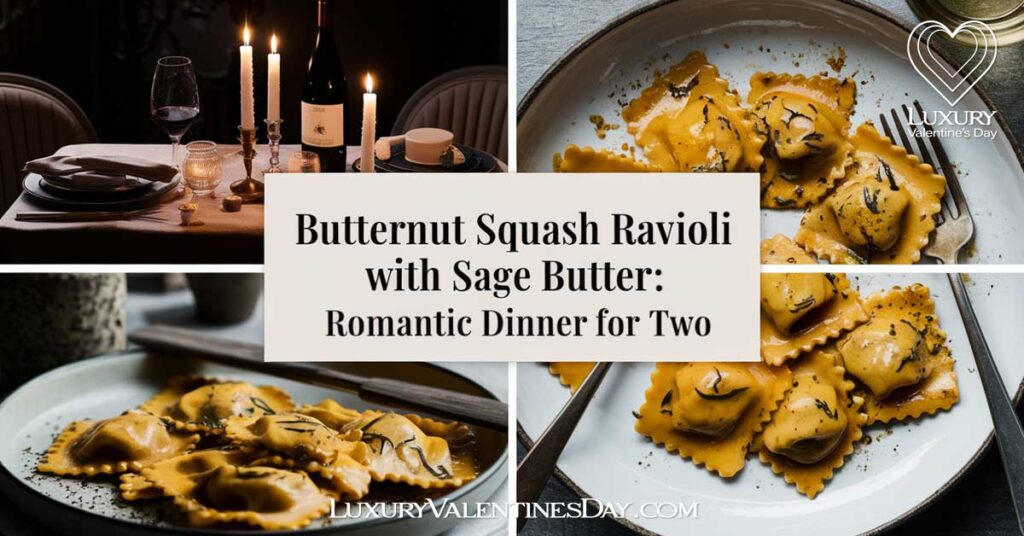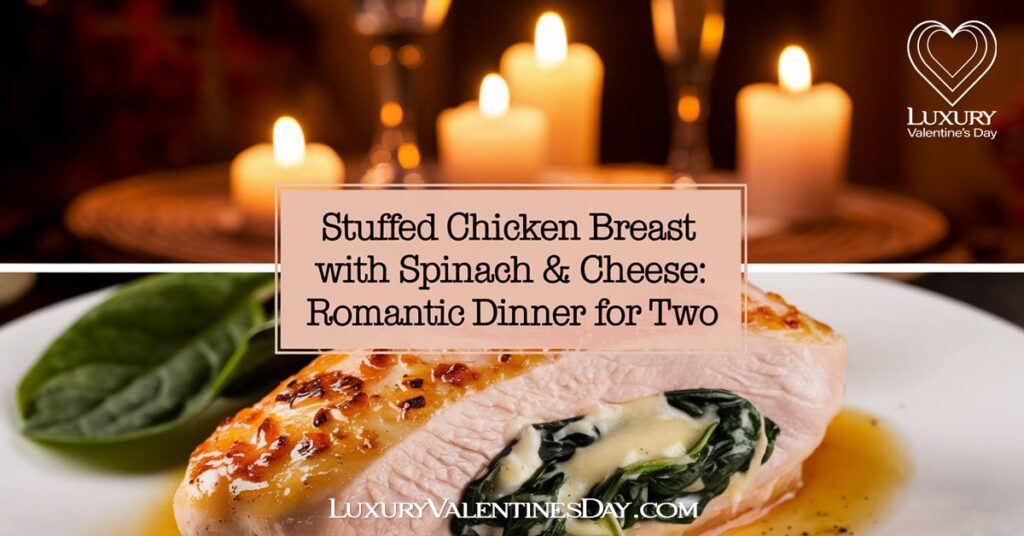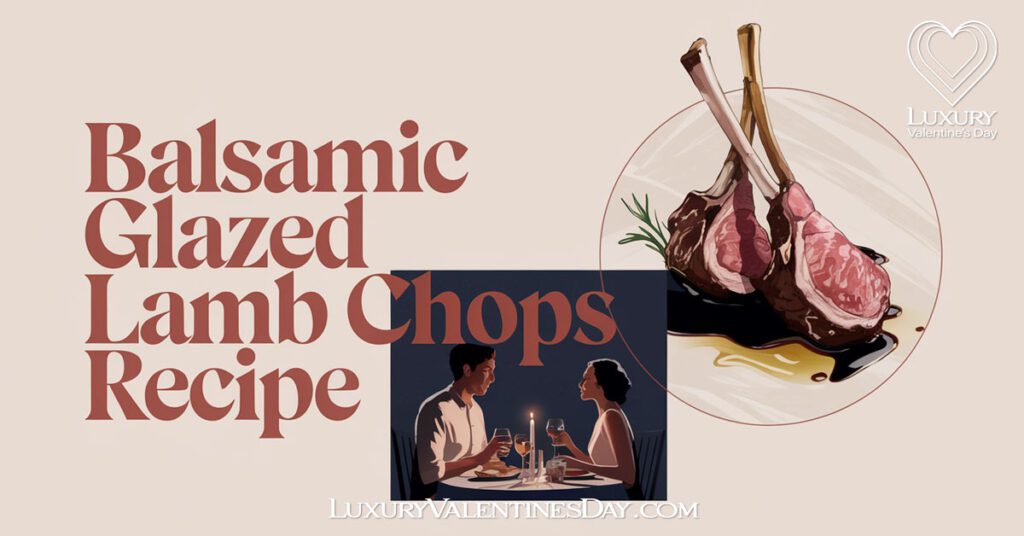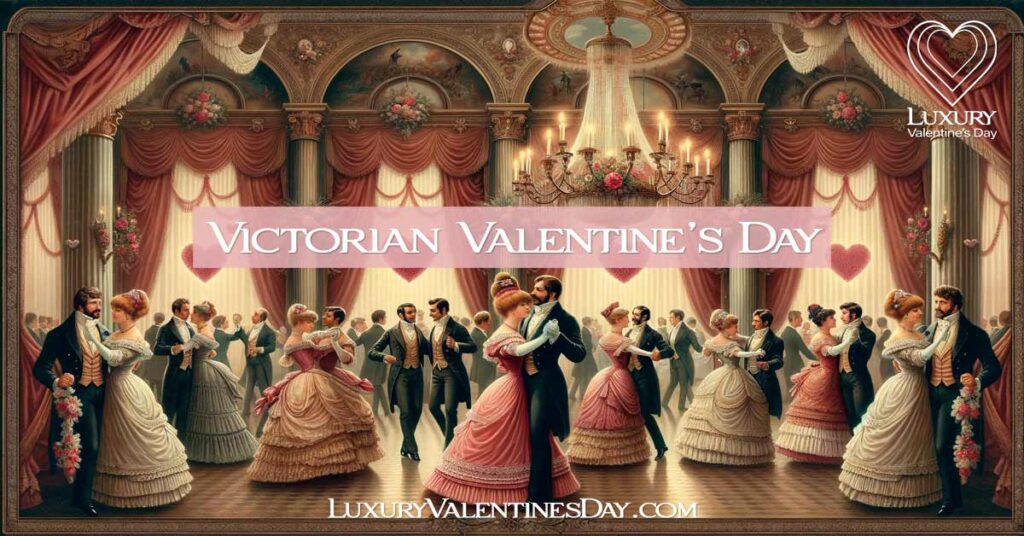
Table of Contents
ToggleDiscovering Love in the Victorian Era: A Valentine’s Day Revelation
Step back in time with me, as we uncover the enchanting world of Victorian Valentine’s Day. Imagine a time when love was whispered through elaborate cards and hidden symbols, where every flower held a secret message. This isn’t just about history and story of Valentine’s Day; it’s about the heart’s language in an era of elegance. I will explore everything from the intricate Victorian Valentine cards to the grandeur of Victorian Valentine’s Day traditions. Whether you’re a hopeless romantic or a history enthusiast, get ready to be captivated by the charm and intricacies of Valentine’s Day in Victorian times.
Key Takeaways:
- Unravel the mystery and allure of Victorian Valentines.
- Dive into the rich history of Victorian Valentine’s Day and its impact on modern celebrations.
- Discover the unique and often overlooked aspects, like Vinegar Valentines and Victorian Valentines decorations.
- Gain insights into the romantic depths of Victorian Valentine poems and the significance of Victorian era Valentine’s Day cards.
- Appreciate how Valentine’s Day Victorian era customs blend seamlessly with today’s celebrations, offering a timeless touch to romance.
The Intricate Romance: The Art of Victorian Valentine’s Cards
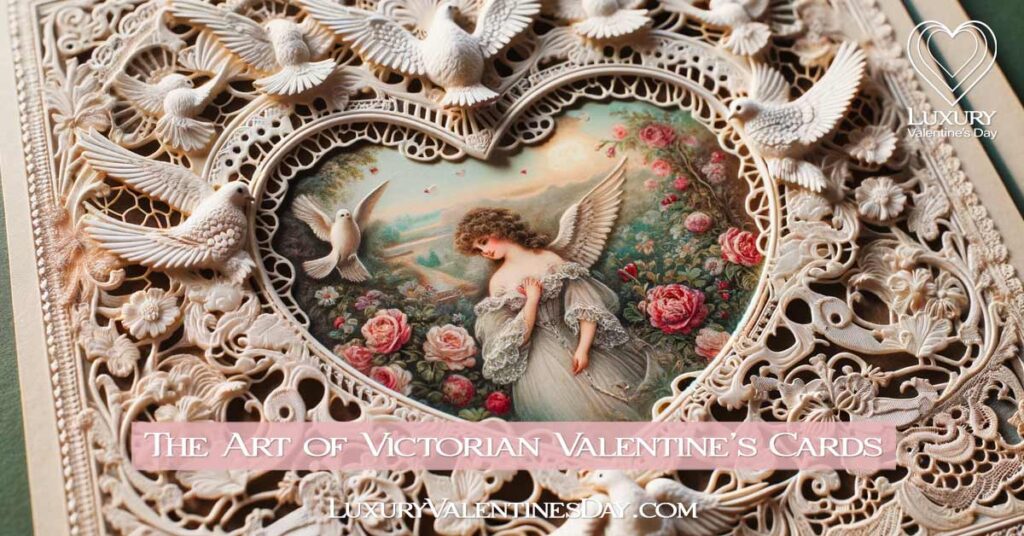
In the Victorian era, expressing love was an art form, and Valentine’s cards were its canvas. These cards weren’t just greetings; they were crafted masterpieces, brimming with intricate designs and hidden messages.
Learn more about the history of Valentine’s Day cards here.
Intricate Valentine Card Designs
Victorian Valentine’s cards were a marvel of craftsmanship. Imagine cards adorned with fine lace, delicate cut-outs, and embossed patterns. They often featured layers of paper that created a three-dimensional effect, adding depth and texture. Hand-painted scenes, gilded edges, and even real fabric or dried flowers were commonly used to embellish these tokens of affection. Each card was a unique piece, reflecting the personal touch of its creator.
Another captivating tradition of Victorian Valentine’s Day was the “Puzzle Purse,” a cleverly folded card that unveiled its secrets layer by layer. These unique cards were masterpieces of creativity and sentiment. As each fold was opened, it revealed verses, messages, and sometimes small tokens of affection. The intricate design of the Puzzle Purse made the act of reading the Valentine a delightful and interactive experience, embodying the charm and thoughtfulness of Victorian romance.
Symbolism and Hidden Messages
The Victorians were enthusiasts of symbolism, especially in matters of the heart. These cards were imbued with a myriad of symbols, each carrying a specific meaning. For instance, a pair of hands clasped symbolized partnership, while an anchor represented hope and steadfastness in love. The use of colors was also significant; red for passion, blue for constancy.
Moreover, many cards contained hidden panels or secret compartments, cleverly designed to conceal a private note or a small trinket. This element of surprise and discovery added an extra layer of meaning to the exchange, making the act of giving and receiving these cards a deeply personal and intimate experience.
The combination of artistic design and symbolic language in Victorian Valentine’s cards made them not just a means of communication but a declaration of love and intent. They reflected the era’s cultural norms and social etiquette, where love was often a nuanced and layered expression.
As we explore the various traditions and customs of Victorian Valentine’s Day, the role of these cards as an emblem of romance becomes ever more apparent. They were not merely part of the celebration; they were at its very heart, encapsulating the spirit and sentiment of Victorian romance.
Love’s Bittersweet Twist: The Tale of Vinegar Valentines
In the midst of Victorian Valentine’s grandeur, there lies a curious and lesser-known tradition: the exchange of “Vinegar Valentines.” These were not your typical declarations of love, but rather, they were the era’s unique take on satire and humor, often bordering on the sardonic.
Unlike the ornate and lovingly crafted Valentine’s cards we’ve explored, Vinegar Valentines were quite the opposite. They were characterized by simple, often crudely-drawn illustrations and contained messages that were teasing, sarcastic, and sometimes downright mean. The purpose? To poke fun, often in a light-hearted manner, but occasionally with a sharper edge.
These cards were sent anonymously, and while some were humorous and well-received, others were used to scorn unrequited love or to reject unwanted advances. The topics ranged from personal traits to social commentary, reflecting the recipient’s perceived flaws or societal norms of the time.
Vinegar Valentines represent a fascinating dichotomy in Victorian romance – where one end of the spectrum celebrated love and affection with elegance and intricacy, the other end wasn’t afraid to delve into the realms of satire and mockery. This tradition sheds light on a more playful, if not cheeky, side of Victorian culture, where even love could have a hint of vinegar.
These Vinegar Valentines remind us that the era’s approach to love wasn’t always serious and formal. It had its own unique sense of humor, one that, albeit unconventional, was an integral part of the Valentine’s Day experience.
Decoding the Language of Love: Symbols in Victorian Valentines
The Victorian era was steeped in symbolism, especially in matters of the heart. Here’s a table that decodes some of the common symbols found in Victorian Valentine’s cards, offering a glimpse into the era’s unique way of expressing emotions. We also include a nod to the sardonic symbols often found in Vinegar Valentines.
| Symbol | Meaning in Traditional Valentines | Meaning in Vinegar Valentines |
|---|---|---|
| Dove | Represents purity and love | N/A |
| Snake biting its tail | Symbolizes eternity | N/A |
| Hands clasped | Partnership and union | Indicative of being ‘tied down’ or trapped |
| Anchor | Hope and steadfastness in love | Implies stubbornness or unwillingness to change |
| Flowers (various types) | Different flowers had specific meanings (e.g., roses for love) | Sometimes used to imply the opposite of their traditional meanings |
| Heart | The universal symbol of love | Overly large hearts could imply a foolishly large heart |
| Cupid | God of love, often seen as a matchmaker | Depicted in clumsy situations to imply clumsiness in love |
| Birds | Symbol of messages and communication in love | Depicted in cages or awkward positions to imply trapped or uncomfortable situations in love |
| Colors (red, blue, etc.) | Red for passion, blue for constancy | Used in excess to imply overbearing emotions or lack of subtlety |
| Skull or Crossbones | N/A | A stark contrast to traditional symbols, indicating a ‘deadly’ or ‘toxic’ relationship |
Elegance and Affection: Victorian Valentine’s Day Traditions
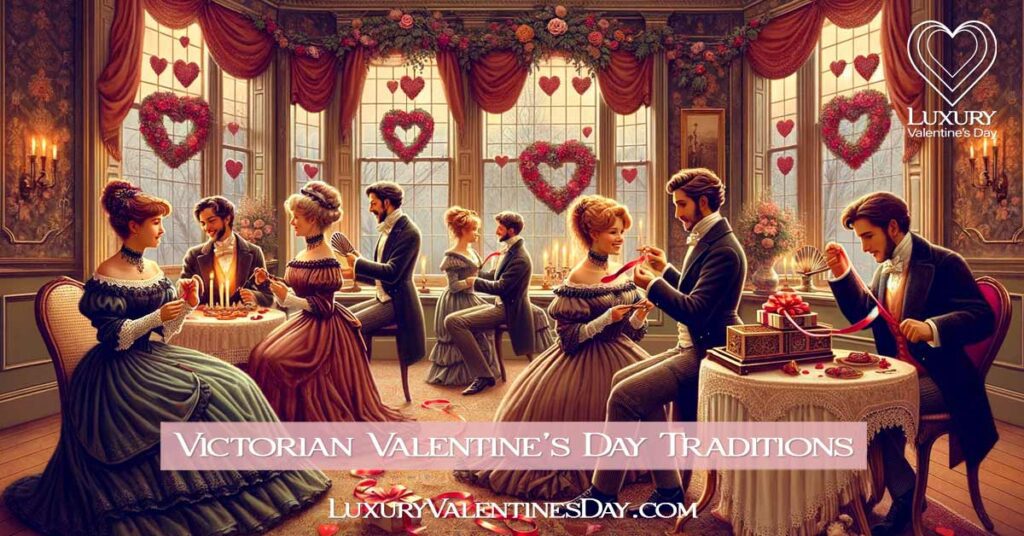
In the enchanting epoch of the Victorian era, Valentine’s Day was celebrated with a splendor that went far beyond the exchange of cards. This section first invites you into the world of Victorian social customs, where grand balls and intimate gatherings were the highlights of Valentine’s Day. It’s a peek into a bygone era of romance, where social events were intricately tied to the expressions of love and affection.
Celebratory Customs and Social Gatherings
During this time there was a canvas for lavish festivities and elaborate social customs. These events were more than mere celebrations; they were a cornerstone of courtship and social etiquette.
Grand Balls and Parties
The Valentine’s Day balls were the pinnacle of these celebrations. Imagine grand halls, opulently decorated with floral arrangements and ribbons, echoing with the sound of orchestras. These balls were not just dances; they were extravagant showcases of romance and social status. Ladies dressed in their finest gowns and gentlemen in their sharpest suits attended these events, each seeking to catch the eye of a potential suitor or to revel in the company of their beloved.
The atmosphere at these balls was charged with anticipation and excitement. Dances like waltzes and polkas were not merely movements to music but a delicate dance of courtship, each step and turn a subtle communication of interest or affection.
Romantic Games and Activities
Aside from dancing, these gatherings often featured a variety of romantic games and activities. ‘Flirting with fans‘ [1] was a popular game where ladies used their fans to convey messages to potential suitors, each flick or flutter carrying a secret meaning. ‘Ribbon pulling‘ was another engaging activity, where ribbons of different colors, each symbolizing a different type of fortune or message in love, were pulled from a central bouquet.
The Art of Conversation
When direct expressions of love were often considered unseemly, conversation at these events was an art form. The ability to engage in witty, intelligent, and subtly flirtatious dialogue was highly valued. Exchanges often included veiled compliments, poetic allusions, and a careful dance around direct expressions of affection, maintaining the era’s standards of decorum and modesty.
Love Gloves
In the realm of Victorian Valentine’s Day traditions, the exchange of “Love Gloves” [2] held a special place. If a gentleman wanted to express his affection, he might present a pair of gloves to the lady of his interest. The real moment of anticipation, however, came on the following Sunday. If the lady wore the gloves to church, it was a public acceptance of his interest and a subtle declaration of mutual affection. This tradition highlights the era’s nuanced and discreet ways of expressing romantic interest, where even a simple pair of gloves could carry significant meaning.
These social gatherings on Valentine’s Day were not just parties; they were the stages on which the intricate ballet of Victorian courtship played out. They reflected the era’s complex rules of romance, where every gesture, word, and glance held significance.
Flowers and Poetry – The Language of Victorian Love
In the Victorian era, where overt expressions of emotion were often constrained by social norms, flowers and poetry became powerful mediums of communication, especially in the realm of love and courtship during Valentine’s Day.
Floriography – The Language of Flowers
Floriography [3], or the language of flowers, was a key aspect of Victorian romance and played a central role in Valentine’s Day celebrations. Each flower had a specific meaning, allowing individuals to express feelings unspoken in words. A bouquet wasn’t just a collection of beautiful blooms; it was a carefully curated message of love and desire.
For instance, red roses symbolized passionate love, while daisies represented innocence and purity. A tulip was a declaration of love, and lilies signified refined beauty. The subtlety of this language allowed for complex messages to be conveyed. A suitor might send a mix of ivy (symbolizing fidelity) and pansies (thoughts) to show his faithful and thoughtful nature.
Poetry – Expressing Love through Verses
Poetry was another cornerstone of Victorian Valentine’s Day. The Victorians revered the written word and the ability to articulate emotions through elegantly composed verses. Poems were often included in Valentine’s cards, ranging from short, sweet verses to lengthy, elaborate compositions.
These poems were not just mere words; they were heartfelt expressions, often personalized and always reflective of the sender’s feelings. A well-chosen poem could capture the essence of one’s affection, admiration, and even longing. It was common for individuals to pen their own verses, pouring their emotions into every line, making their messages deeply personal and touching.
Combining Flowers and Poetry
The most impactful Valentine’s gestures often combined both flowers and poetry. Imagine a bouquet of violets (faithfulness) accompanied by a poem about unwavering devotion, or a single red rose (love at first sight) paired with a verse that speaks of instant connection and deep affection.
This combination of floriography and poetry allowed Victorians to navigate the complexities of their emotions and societal expectations, creating a form of communication that was both beautiful and meaningful. It was a dance of subtlety and elegance, where every flower and every word held weight, weaving a tapestry of romantic sentiment that is still admired today.
Whispers of Petals: The Language of Flowers in Victorian Romance
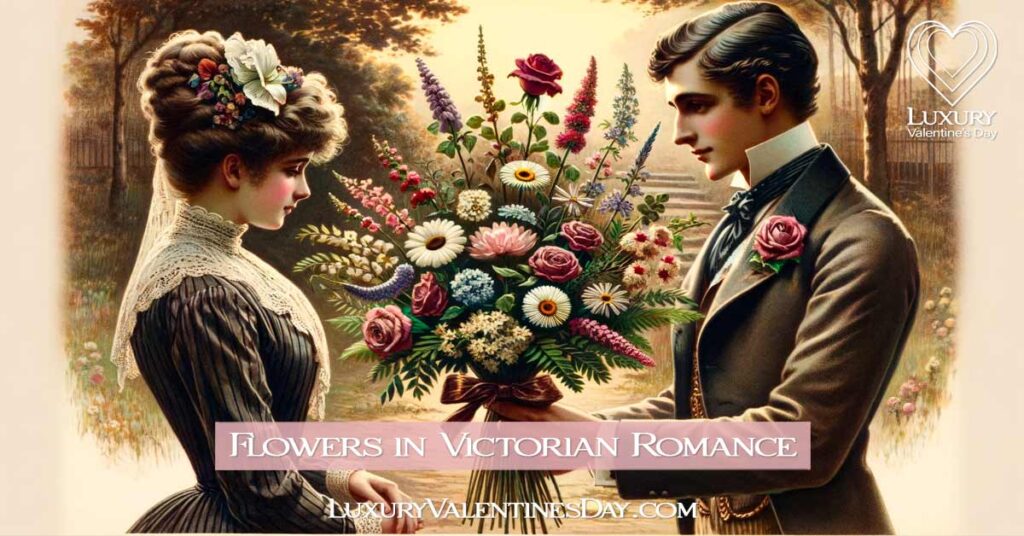
In the tapestry of Victorian romance, flowers were not mere decorations; they were silent messengers of the heart. This section first delves into the fascinating practice of floriography, the Victorian art of using flowers to convey emotions and messages. We’ll explore how this intricate language formed an essential part of Valentine’s Day expressions, allowing lovers to communicate in a society where direct expression was often frowned upon.
Expressing Emotions and Messages Through Flowers
In the restrained social climate of the Victorian era, the language of flowers, or floriography, emerged as a nuanced form of communication, especially in the realm of romance. This botanical code became an integral part of expressing feelings during Valentine’s Day, allowing individuals to convey sentiments that were otherwise difficult to express openly.
The Art of Choosing Flowers
The selection of flowers for a Valentine’s bouquet was a thoughtful process, laden with meaning. Each flower held a specific symbolism, and the combination of different blooms could create complex messages. It was a way of communicating emotions ranging from love and desire to rejection and disdain, all without saying a word.
Conveying Hidden Messages
The Victorians were adept at using flowers to send hidden messages. For example, sending a bouquet of red roses expressed deep love and passion, while yellow roses might subtly imply jealousy or a decrease in affection. A mix of flowers could convey a nuanced message, such as combining lilacs (first love) with ivy (fidelity) to indicate a committed and enduring first love.
Societal Implications
The use of floriography was particularly significant in a society where direct expression of one’s feelings was often considered inappropriate. It allowed people to navigate the complex social rules of courtship and express their emotions within the accepted boundaries of Victorian decorum. Receiving a bouquet was akin to receiving a secret letter, with each flower adding to the depth of the message.
Flower Arrangements and Presentations
The presentation of these flowers also held meaning. The way a bouquet was tied, the direction in which a flower was presented, and even the hand used to give the flowers could add layers to the message. For instance, a flower presented with the right hand would typically signify a positive response or feeling, while the left hand would indicate a negative response or rejection.
Through floriography, Victorians found a way to express the depth and complexity of their emotions, especially on Valentine’s Day. This elegant, unspoken language of flowers added a layer of intrigue and sentiment to their romantic exchanges, making every bouquet a deeply personal and meaningful gift.
Specific Flowers and Their Meanings in Valentine’s Day Context
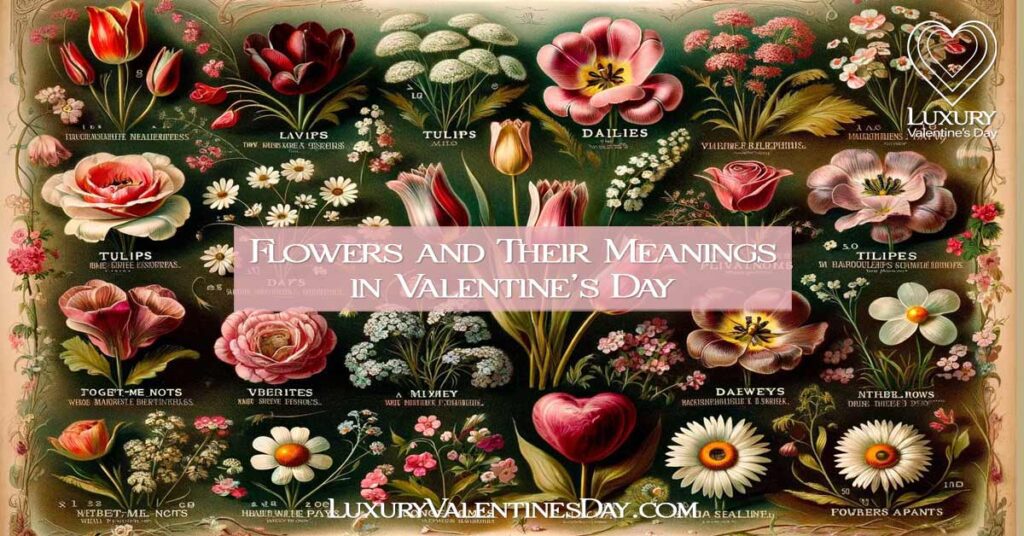
In Victorian Valentine’s Day celebrations, the choice of specific flowers was of paramount importance, as each bloom carried its own secret message. Let’s explore some of the most significant flowers and their meanings in the romantic lexicon of the era.
1. Red Rose – Love and Passion
The quintessential symbol of romantic love, the red rose, was perhaps the most powerful flower in the Victorian Valentine’s arsenal. It unequivocally declared deep love and burning passion. A bouquet of red roses was a bold expression of one’s heart’s desire.
2. Lily – Purity and Beauty
Lilies, with their elegant form and fragrance, were often associated with purity and refined beauty. A Victorian suitor might include lilies in a bouquet to signify admiration for the recipient’s noble beauty and grace.
3. Tulip – Declaration of Love
The tulip, particularly the red tulip, was a declaration of love in the Victorian flower language. Sending tulips on Valentine’s Day was a way to boldly yet elegantly confess one’s love.
4. Violet – Faithfulness
Violets, with their delicate appearance, signified faithfulness and steadfastness. A bouquet of violets indicated the sender’s loyal intentions and enduring affection.
5. Daisy – Innocence:
Daisies represented innocence and pure affection. They were often included in Valentine’s bouquets as a symbol of gentle, undemanding love.
6. Forget-Me-Not – True Love and Memories
As the name suggests, forget-me-nots were symbols of true love and fond memories. Including these in a Valentine’s bouquet was a promise to always remember and cherish the recipient.
7. Orchid – Exotic Beauty and Refinement
Orchids were associated with exotic beauty and refinement. Gifting orchids was a way to admire the unique and sophisticated nature of the relationship or the recipient.
8. Hyacinth – Playfulness and Sport
The hyacinth, with its variety of colors, had different meanings. Generally, it signified playfulness and a sportive nature, adding a light-hearted touch to a Valentine’s message.
This floral language added depth and nuance to Valentine’s Day in the Victorian era. The flowers chosen for a bouquet were not just a gesture of affection but a carefully crafted message, a poetic expression of the heart’s deepest feelings.
Bouquets of Emotion: Deciphering Victorian Flower Meanings
The Victorian era’s language of flowers, or floriography, was rich and varied. Here’s a detailed table that decodes some of the popular flowers and their meanings in this fascinating botanical language. Each bloom held a world of emotion and sentiment, perfect for expressing the unspoken on Valentine’s Day.
| Flower | Victorian Meaning |
|---|---|
| Red Rose | Deep love, Passion |
| Pink Rose | Admiration, Sympathy |
| White Rose | Innocence, Purity |
| Yellow Rose | Friendship, Jealousy |
| Lily | Purity, Majesty |
| Tulip (General) | Love, Passion |
| Tulip (Red) | Declaration of Love |
| Tulip (Yellow) | Hopeless Love |
| Violet | Faithfulness, Modesty |
| Daisy | Innocence, Loyal Love |
| Forget-Me-Not | True Love, Memories |
| Orchid | Exotic Beauty, Refinement |
| Hyacinth (General) | Playfulness, Sport |
| Hyacinth (Blue) | Consistency |
| Hyacinth (Purple) | Sorrow, Apology |
| Hyacinth (White) | Loveliness, Prayers for Someone |
| Ivy | Fidelity, Marriage |
| Pansy | Thoughtful Reflection, Remembrance |
| Lilac (White) | Youthful Innocence |
| Lilac (Purple) | First Emotions of Love |
| Peony | Bashfulness, Shame |
| Carnation (Red) | Admiration, Heartache |
| Carnation (Pink) | A Woman’s Love |
| Carnation (Yellow) | Disdain, Rejection |
Romance Woven in Words and Colors: The Influence of Literature and Art on Victorian Valentine’s Day
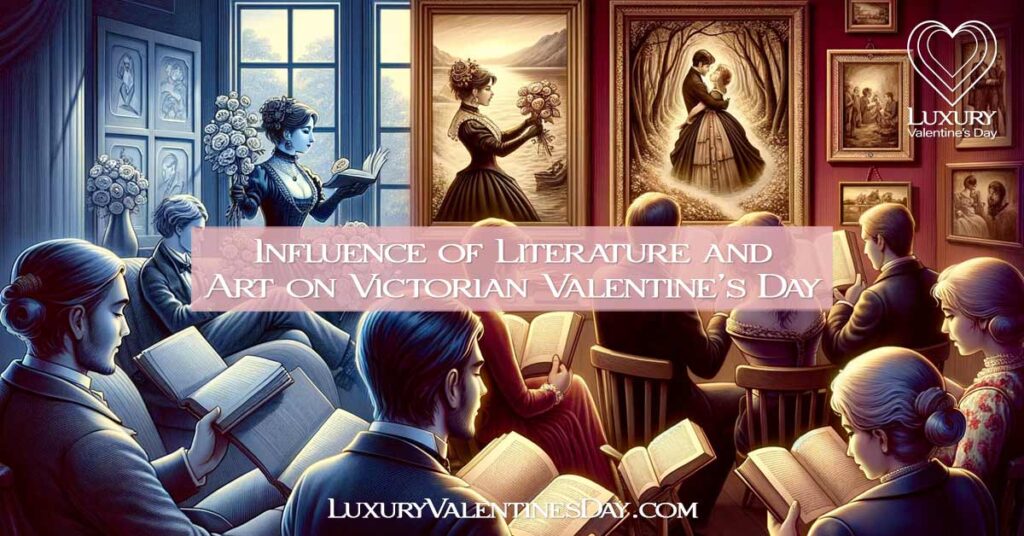
Literature and art were not mere pastimes in Victorian times; they were the lifeblood of culture and romance. This section explores how these two powerful forms of expression profoundly influenced Valentine’s Day practices. We begin by delving into the impact of Victorian literature and art, understanding how they shaped the romantic ideals and customs of the time.
The Impact of Victorian Literature and Art on Valentine’s Day Practices
The Victorian era was a golden age of literature and art, with both mediums playing a significant role in shaping societal norms and romantic ideals. During this time, Valentine’s Day practices were heavily influenced by the themes and motifs popularized through these cultural expressions.
Literature: Shaping Romantic Ideals
Victorian literature was rife with themes of love, courtship, and idealized romance. Authors like Jane Austen, Charlotte Brontë, and Elizabeth Barrett Browning penned works that not only captivated readers but also set standards for romantic relationships. These literary works often portrayed love as a noble, passionate, and sometimes tragic experience, deeply influencing how Victorians viewed love and courtship.
The influence of these narratives extended to Valentine’s Day customs. The idealized portrayals of love in literature encouraged a culture of romanticism and chivalry that was reflected in the elaborate Valentine’s Day cards, letters, and poems exchanged during this time. The eloquent language and heartfelt sentiments found in Victorian literature became the template for the messages lovers would write to each other.
Art: Depicting the Aesthetics of Romance
Similarly, Victorian art played a vital role in shaping the aesthetics of Valentine’s Day. Artists like John Everett Millais and Dante Gabriel Rossetti, members of the Pre-Raphaelite Brotherhood, depicted love and beauty in a way that captivated the Victorian imagination. Their works often featured romantic, medieval, and classical themes, filled with symbolic imagery and rich colors.
These artistic representations influenced the design and decoration of Valentine’s Day cards and gifts. The intricate, ornate style of Victorian art was mirrored in the elaborate lacework, floral motifs, and romantic imagery adorning Valentine’s cards. Art provided a visual language of love that was both idealized and deeply sentimental, echoing the era’s fascination with beauty and romance.
The combined influence of literature and art in Victorian times created a Valentine’s Day culture that was rich in romantic expression, both in words and visuals. This period saw the intertwining of cultural ideals with personal expressions of love, setting a standard for romantic gestures that still echoes in modern celebrations.
Celebrated Authors and Artists and Their Impact on Valentine’s Day

The Victorian era was graced with literary and artistic giants whose works not only defined the cultural landscape but also left an indelible mark on the way Valentine’s Day was celebrated. Let’s explore some of these influential figures and their contributions.
Jane Austen’s Reflections on Courtship:
Jane Austen [4], with her keen observations of love and courtship, greatly influenced Victorian ideals of romance. Her novels, such as “Pride and Prejudice” and “Sense and Sensibility,” showcased witty dialogue, complex characters, and intricate social dynamics. The subtlety and intelligence of Austen’s characters in navigating relationships became a model for Victorian courtship, inspiring the eloquent and thoughtful exchanges that characterized Valentine’s Day correspondence
The Brontë Sisters’ Passionate Narratives:
Charlotte, Emily, and Anne Brontë [5] brought a depth of passion and intensity to Victorian literature. Works like “Jane Eyre” and “Wuthering Heights” depicted love in its most intense and sometimes tumultuous forms. These narratives influenced the Victorian approach to Valentine’s Day, encouraging expressions of deep, passionate emotions, often reflected in the heartfelt and sometimes dramatic messages in Valentine’s cards and poems.
Elizabeth Barrett Browning’s Romantic Poetry:
Elizabeth Barrett Browning’s [6] poetry, particularly “Sonnets from the Portuguese,” was a testament to the power of love. Her famous line, “How do I love thee? Let me count the ways,” became emblematic of romantic expression. Her sonnets, celebrating love with elegance and depth, were often quoted in Valentine’s Day cards and letters, encapsulating the era’s idealization of romantic love.
Pre-Raphaelite Artists’ Romantic Imagery:
The Pre-Raphaelite Brotherhood [7], with artists like Dante Gabriel Rossetti and John Everett Millais, influenced the visual aspects of Valentine’s Day. Their art, characterized by vivid colors, detailed nature scenes, and medieval romantic themes, inspired the designs of Valentine’s cards. The imagery in these cards often mirrored the romantic, idealized scenes depicted in Pre-Raphaelite paintings, adding a layer of artistic beauty to the expressions of love.
These authors and artists collectively shaped the Victorian Valentine’s Day experience. Their works not only reflected the ideals and emotions of the time but also provided a rich source of inspiration for the ways love was expressed during the holiday. Their legacy continues to influence how we perceive and celebrate love today.
From Past to Present: The Legacy of Victorian Valentine’s Day in Modern Celebrations
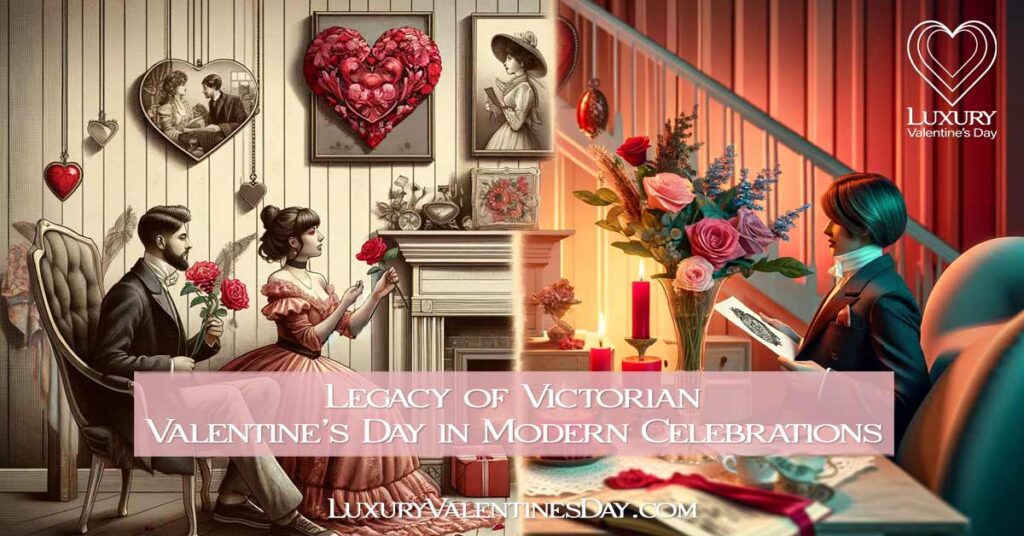
The echoes of Victorian Valentine’s Day resonate even in our modern celebrations. This section uncovers the enduring connections between the romantic customs of the Victorian era and the ways we celebrate love today. We begin by exploring how these age-old traditions have influenced and intertwined with contemporary Valentine’s Day practices.
Tracing the Victorian Influence in Today’s Celebrations
The charm and customs of Victorian Valentine’s Day have left a lasting imprint on how we celebrate the day of love in the modern era. Many practices that originated in the 19th century continue to shape our current traditions, creating a bridge between the past and the present.
Continued Popularity of Valentine’s Cards: The tradition of exchanging Valentine’s cards, which gained immense popularity during the Victorian era, remains a cornerstone of today’s Valentine’s Day. While the style and design of the cards have evolved, the sentiment behind them – expressing love and affection – remains unchanged. Today’s cards range from simple and heartfelt to elaborate and ornate, mirroring the Victorian penchant for intricate and artistic expressions of love.
Floriography: A Subtle Influence: The Victorian language of flowers, or floriography, still subtly influences modern Valentine’s Day flower choices. Red roses continue to be a popular symbol of love and passion, a direct inheritance from Victorian romantic practices. Other flowers, like tulips and lilies, are also chosen for their traditional meanings, echoing the Victorian tradition of conveying messages through floral arrangements.
Romantic Literature and Art: Victorian literature and art continue to inspire modern romantic gestures and celebrations. Quotes from Victorian poets and novelists are often used in Valentine’s Day cards and gifts, and the era’s artistic styles influence the design of modern Valentine’s merchandise. The romanticism and idealism of the Victorian era still captivate the modern imagination, offering a touch of elegance and nostalgia.
Evolving Social Practices: While modern society is more open in expressing love and affection, some of the subtleties and nuances of Victorian courtship can still be seen in contemporary Valentine’s Day customs. The emphasis on thoughtfulness, the enjoyment of shared experiences, and the value of personal, heartfelt gifts are principles that have their roots in Victorian traditions.
In these ways and more, the legacy of Victorian Valentine’s Day continues to be felt in the 21st century. It’s a testament to the enduring nature of love and the timeless appeal of romantic gestures, bridging centuries and evolving through generations.
Evolution and Preservation of Victorian Traditions
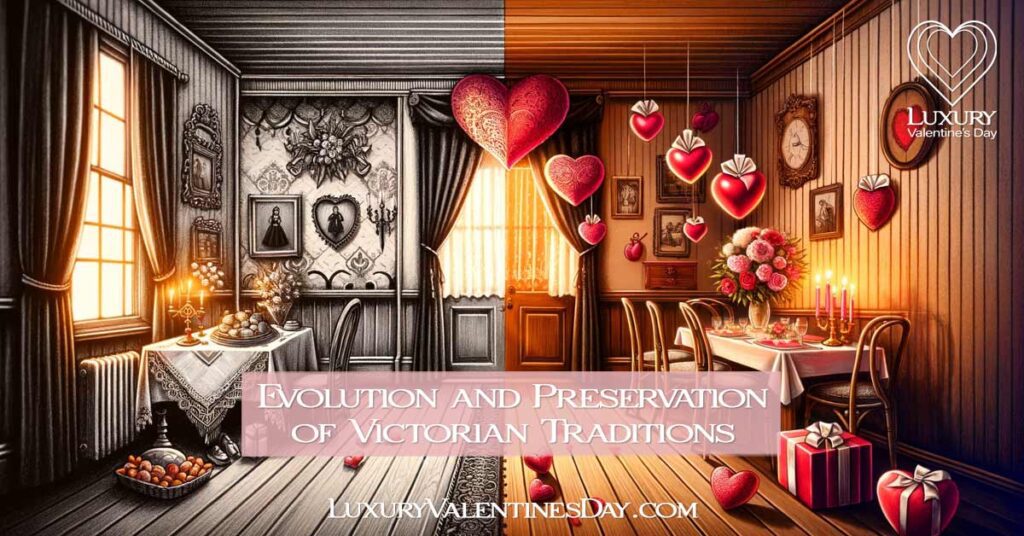
While the essence of Victorian Valentine’s Day traditions continues to influence modern celebrations, these customs have also undergone significant evolution and adaptation to fit contemporary sensibilities and practices.
Transformation of Valentine’s Cards: Victorian Valentine’s cards were ornate and elaborate, often handmade with lace and ribbons. In modern times, while some still prefer traditional, intricate designs, there has been a shift towards a wider variety of styles. This includes minimalist designs, digital cards, and even humorous or quirky themes. The evolution of these cards reflects changes in aesthetic preferences and the impact of technology on personal expression.
Modern Interpretations of Floriography: The language of flowers, a quintessential part of Victorian romance, has seen a reinterpretation in the modern era. While the basic symbolism of some flowers remains, contemporary Valentine’s Day often sees a more personalized approach to floral gifts. People now choose flowers based on personal preferences, color themes, or even the recipient’s favorite blooms, rather than strictly adhering to traditional meanings.
Literature and Art in Contemporary Romance: The influence of Victorian literature and art endures, but with a modern twist. Today, these influences are often merged with contemporary themes and sensibilities. For instance, quotes from Victorian poets might be set against modern art or used in innovative ways, such as in social media posts or as part of interactive digital gifts.
Shifts in Social and Cultural Practices: Social and cultural shifts have also impacted how we celebrate Valentine’s Day. The Victorian era’s formal courtship rituals have given way to more varied and individualistic expressions of love. Modern Valentine’s Day is inclusive of a broader spectrum of relationships and celebrates love in its many forms. The day is now marked not only by romantic partners but also celebrated among friends, family, and even as a form of self-love and self-care.
The evolution of Victorian Valentine’s Day traditions into modern times shows how customs adapt to changing societal norms while retaining their core essence. This ongoing transformation highlights the timeless nature of love and the universal desire to express and celebrate it.
Timeless Traditions: Top 5 Victorian Valentine’s Practices Alive Today
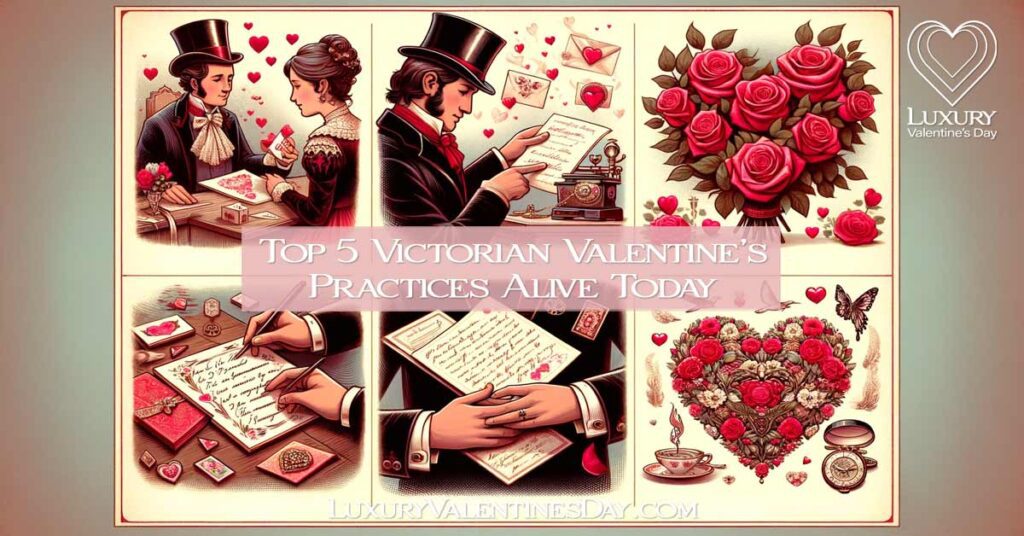
While times have changed, some Valentine’s Day customs from the Victorian era continue to charm us even today. Here are the top 5 practices that have stood the test of time:
- Exchanging Valentine’s Cards:
- Then: Intricately designed and often handmade, Victorian Valentine’s cards were a work of art, featuring lace, embossing, and romantic imagery.
- Now: The tradition continues with a vast array of card styles, from elegant and romantic to modern and digital, but the sentiment of expressing love through a written card remains unchanged.
- Giving Flowers, Especially Roses:
- Then: Victorians used floriography, the language of flowers, to send secret messages of love and affection, with roses symbolizing deep love.
- Now: Roses, particularly red ones, remain the quintessential Valentine’s Day flower, symbolizing love and passion across the globe.
- Writing Love Letters and Poems:
- Then: Romantic, handwritten love letters and poems were a staple of Victorian courtship, often included with Valentine’s gifts.
- Now: Personalized love letters and poetry are still cherished, seen as a deeply personal and heartfelt way to express one’s feelings.
- Using Symbolic Jewelry and Gifts:
- Then: Lovers often exchanged jewelry like lockets and brooches, which held sentimental value and sometimes contained hidden messages or portraits.
- Now: Gifting jewelry remains a popular Valentine’s Day practice, with pieces often chosen for their symbolic meanings (like heart pendants signifying love).
- Hosting Valentine’s Day Social Events:
- Then: Valentine’s Day balls and parties were common, offering a chance for socializing and celebrating love.
- Now: While the grand balls might not be as common, Valentine’s Day is still an occasion for romantic dinners, parties, and social gatherings.
These practices, originating in the Victorian era, continue to be integral parts of Valentine’s Day celebrations, proving that some traditions truly are timeless.
Embracing the Past, Celebrating the Present: The Timeless Romance of Victorian Valentine’s Traditions
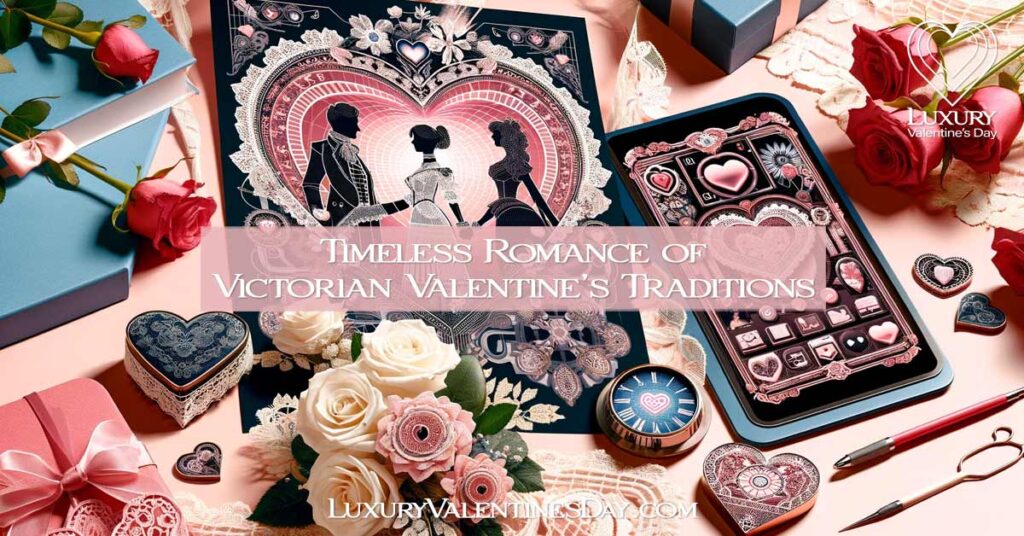
As our journey through the romantic customs of Victorian Valentine’s Day comes to a close, it’s clear that the era’s influence on modern celebrations is both profound and enduring. The Victorian approach to romance, with its emphasis on eloquence, symbolism, and thoughtful gestures, has left an indelible mark on how we express love today.
The intricate Valentine’s cards, the poetic language of flowers, the heartfelt letters, and the grand social gatherings of the Victorian era may have evolved over time, but their essence remains. They remind us of a time when romance was not just an emotion but an art form, where expressing love was about creating something beautiful and meaningful.
In today’s fast-paced world, where digital communication often prevails, the Victorian traditions invite us to slow down and savor the art of personal, thoughtful expressions of affection. They encourage us to look beyond the surface and find deeper meanings in our gestures of love.
Whether it’s through a carefully chosen bouquet, a beautifully written card, or a thoughtful gift, the spirit of Victorian romance continues to inspire us. It teaches us that love, in all its forms, is timeless and that some traditions are worth preserving and adapting for generations to come.
So, as we celebrate Valentine’s Day, let’s embrace a touch of Victorian elegance and sentimentality. Let’s remember that sometimes, looking back to the past can be a wonderful way to enrich our present and future celebrations of love.
Referrences
[1] Article “Let the Fan Do the Talking: Flirting in the Victorian Era” published on the National Trust for Scotland website https://ntsusa.org/fan-victorian-flirting/
[2] Article “Victorian Lessons: How to Flirt with Gloves, the Importance of Ring Position, and Writing Love Letters that Get You Married (or not)” by Susanna Ives : https://susannaives.com/wordpress/2012/06/victorian-lessons-how-to-flirt-with-gloves-the-importance-of-ring-position-and-writing-love-letters-that-get-you-married-or-not/
[3] Article “The Ultimate Guide to Flower Meanings : Learn how to say it with flowers” on the Inferflora website https://www.interflora.co.uk/page/flower-meanings
[4] Jane Austen, from Jane Austen’s House https://janeaustens.house/jane-austen/
[5] The Brontë family, from the Brontë Society abd Brontë Parsonage Museum https://www.bronte.org.uk/the-brontes-and-haworth/family-history
[6] Elizabeth Barrett Browning by Jessica Brain on the Historic UK website https://www.historic-uk.com/CultureUK/Elizabeth-Barrett-Browning/
[7] “The Pre-Raphaelites” by Jennifer Meagher for the MET https://www.metmuseum.org/toah/hd/praf/hd_praf.htm
Related Posts
- Romantic Restaurants for the Perfect Date Night in Raleigh, NC
- Cookies Decorated with Sugar Sprinkles and Pearls: Simple Tips for Beautiful Results
- Alphabet Date Ideas: A to Z Guide for Creative Couples
- Cookies Decorating Ideas with Edible Flowers: Beautiful Ideas and Tips
- Valentine’s Day Event Decor Ideas: Create Unforgettable and Stylish Celebrations
- Easy Valentine’s Day Decor Ideas: Simple and Stylish Ways to Celebrate Love









